This guide initially displays common reptiles and amphibians of all shapes. Use the selectors below to view particular shapes, include rare species, or search by name.
Reptiles are a group of vertebrate animals that are cold-blooded, i.e., they regulate their inner body temperature by responding to the temperature of their environment, basking in the sun to warm themselves up or lying in the shade to cool off. Animals in the class Reptilia include snakes, lizards, crocodiles, turtles and tortoises. All of these creatures are covered in scales and breathe air through their lungs throughout their lifetime. In addition, they all produce eggs. Most reptiles lay eggs from which young hatch directly after an incubation period. However, some snakes, including rattlesnakes, carry their eggs internally and then give birth to live young.
Like reptiles, amphibians (frogs, toads, newts, salamanders and worm-like caecilians) are cold-blooded vertebrates. However, unlike reptiles, animals in the class Amphibia do not have scales but rather have skin that is permeable so that molecules and gases can pass through it. In addition, they lay their eggs in water where the young are born as larvae using gills to breath. The larvae grow and change into the adult form. This process includes developing lungs thus allowing the adults to live on land. Amphibians are considered to be the link between fish and reptiles as they were the first animals to leave the water and come onto land.
The question often arises of how to tell the difference between a frog and a toad. Although they are closely related amphibians, there are some features that can be used to distinguish them. Frogs have long hind legs for jumping, moist and usually smooth skin and bulging eyes. In addition, they typically stay in water. Toads have short legs for walking and hopping, dry and bumpy skin and do not have bulging eyes but do have poison glands behind their eyes. They mostly stay on land.
This guide describes the modest number of amphibians and reptiles including two venomous snakes that can be found in Los Alamos and the surrounding areas. An excellent reference for more information is Amphibians and Reptiles of Los Alamos County by Teralene S. Foxx, Timothy K. Haarmann, and David C Keller.
Reptile and Amphibian References
Amphibiaweb
Amphibians and Reptiles of Los Alamos County [PDF]
Bartlett, R.D., Bartlett, P.P., 2013 New Mexico’s Reptiles and Amphibians: A Field Guide. University of NM Press
Biota Information System of New Mexico
Degenhardt, W.G., Painter, C.W., Price, A.H., 2005 Amphibians and Reptiles of New Mexico. University of NM Press
eNature
Encyclopedia of Life
New Mexico Herpetological Society
The Reptile Database
Subject Area Experts (all guides)
Steve Cary (butterflies)
Beth Cortright (insects)
Terry Foxx (invasive plants)
Leslie Hansen (mammals)
Richard Hansen (fish, mammals)
Dorothy Hoard (butterflies, trees)
Chick Keller (flowers, herbarium)
Shari Kelley (geology)
Kirt Kempter (geology)
Garth Tietjen (reptiles)
David Yeamans (birds)
Web Development and Content Management
Pat Bacha
Jennifer Macke
Graham Mark
Akkana Peck
Contact
Please contact us for local nature questions and sightings. We welcome comments, corrections, and additions to our guides.
For more information about local nature, please visit our Nature Blog or subscribe to PEEC This Week.
Make Selection
 Photo: Jerry Oldenettel |  Blackneck Garter Snake(Thamnophis cyrtopsis)Family: Colubridae (Advanced Snakes) Size: 16 - 43 in (41 - 109 cm) Status: native; uncommon Habitat: desert flats with mesquite, pine-fir forests, near water sources; up to 8,750 ft (2,700 m) Nonvenomous. There are two large black blotches at the neck. The underside is pale gray or cream. Tracks Info Photos Distribution |
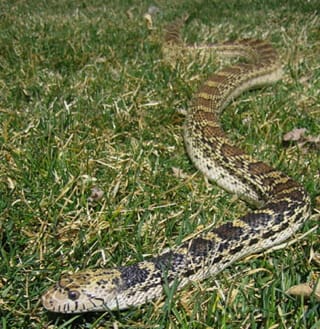 Photo: Jennifer Macke |  Bullsnake, Western Gopher Snake(Pituophis catenifer)Family: Colubridae (Advanced Snakes) Size: 48 - 96 in (122 - 244 cm) Status: native; common Habitat: prairie and open wooded areas. Nonvenomous. Often mistaken for rattlesnakes, will even shake its tail when threatened, although it does not have rattles. Color varies widely, but usually yellowish or light tan background with brown or reddish saddles down the back. Long, thin shaped head. Excellent rodent feeder, very beneficial snake. Tracks Info Photos Distribution Featured |
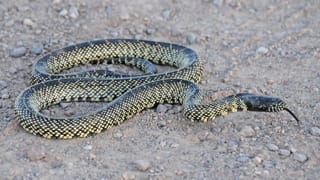 Photo: Jerry Oldenettel |  Desert Kingsnake(Lampropeltis getula splendida)Family: Colubridae (Advanced Snakes) Size: 36 - 45 in (91 - 114 cm) Status: native; uncommon Habitat: rural and mesa areas near rivers and streams Typical location: White Rock Canyon Nonvenomous. Nocturnal. Mostly black with yellow or whitish speckles. The head is usually very dark. For people afraid of rattlers, this snake is actually your best friend... they EAT rattlesnakes, and other snakes too! Found in lower-elevation areas surrounding Los Alamos. Tracks Info Photos Distribution |
 Photo: Gary Nafis, California Herps |  Desert Striped Whipsnake(Coluber taeniatus taeniatus, Masticophis taeniatus taeniatus)Family: Colubridae (Advanced Snakes) Size: 40 - 72 in (102 - 183 cm) Status: native; common Habitat: variety of habitats from grassy areas to mountainous terrain with open woodlands; up to 9,400 ft (2,850 m) Typical location: White Rock, White Rock Canyon Nonvenomous. Often seeks shelter in rocky outcrops, rodent burrows and in shrubs and trees. Tracks Info Photos Distribution |
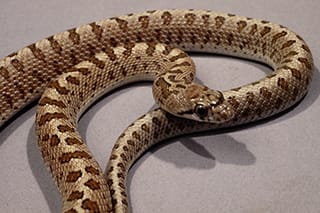 Photo: Kerry Matz |  Glossy Snake(Arizona elegans)Family: Colubridae (Advanced Snakes) Size: 30 - 42 in (76 - 107 cm) Status: native; rare Habitat: open areas and scrubland Typical location: White Rock Nonvenomous. Similar in color to the bull snake, but distinguished by its smooth, shiny scales. Secretive and nocturnal. Tracks Info Photos Distribution |
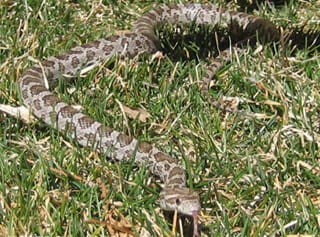 Photo: Jennifer Macke |  Great Plains Rat Snake, Corn Snake, Red Corn Snake(Pantherophis emoryi, Pantherophis guttata, Elaphe guttata)Family: Colubridae (Advanced Snakes) Size: 36 - 60 in (91 - 152 cm) Status: native; uncommon Habitat: open grassy areas and lightly forested areas Typical location: White Rock Nonvenomous. Nocturnal. As the name implies, this snake for good for rodent control. Tracks Info Photos Distribution |
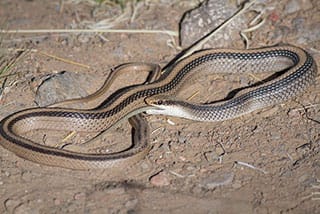 Photo: Mouser Williams |  Mountain Patch-nosed Snake(Salvadora grahamiae)Family: Colubridae (Advanced Snakes) Size: 22 - 47 in (56 - 119 cm) Status: native; uncommon Habitat: open woodland and forested mountain slopes above 4,000 ft (1,200 m) Typical location: Frijoles Canyon, White Rock, White Rock Canyon Nonvenomous. Secretive. When approached this snake can bolt to cover with amazing speed. Tracks Info Photos Distribution |
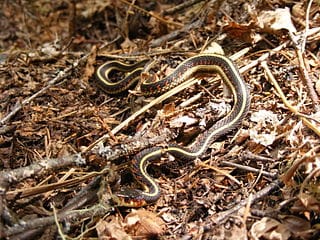 Photo: Jesse Taylor |  New Mexico Garter Snake(Thamnophis sirtalis dorsalis)Family: Colubridae (Advanced Snakes) Size: 16 - 43 in (41 - 109 cm) Status: native; uncommon Habitat: grassy areas along water Typical location: Rio Grande at lower elevations Nonvenomous. Subspecies of the common Garter Snake. Tracks Info Photos Distribution |
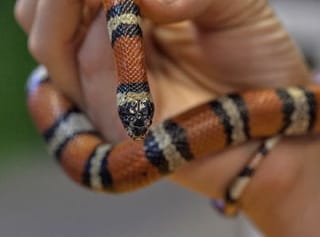 Photo: Elena Giorgi |  New Mexico Milk Snake(Lampropeltis triangulum celaenops)Family: Colubridae (Advanced Snakes) Size: 24 - 36 in (61 - 91 cm) Status: native; rare Habitat: varied areas from high foothills to coniferous forest Typical location: Rio Grande at lower elevations Nonvenomous. The milk snake is very secretive and nocturnal. They have not been documented on the Pajarito Plateau, but do inhabit nearby areas of the Rio Grande valley and areas farther south. Tracks Info Photos Distribution |
 Photo: Dawson 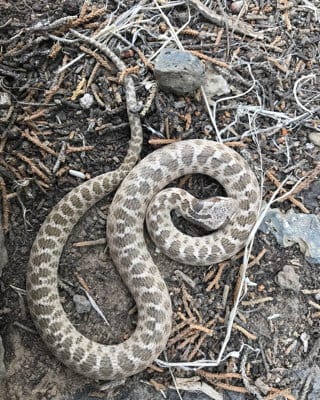 Photo: Beth Cortright |  Night Snake(Hypsiglena torquata)Family: Colubridae (Advanced Snakes) Size: 12 - 26 in (30 - 66 cm) Status: native; uncommon Habitat: semiarid and arid sandy or rocky areas; up to 7,000 ft (2,100 m) Typical location: White Rock Canyon Nonvenomous. Nocturnal. May be mistaken for a young rattler but the night snake has a tail that tapers to a point and lacks a rattle. Tracks Info Photos Distribution |
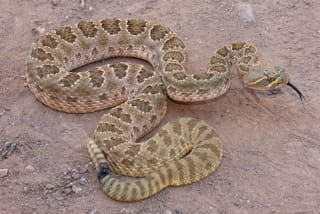 Photo: J.N. Stuart |  Prairie Rattlesnake, Western Rattlesnake(Crotalus viridis)Family: Viperidae (Rattlesnakes and Other Vipers) Size: 16 - 64 in (41 - 163 cm) Status: native; common Habitat: rocky areas, slopes and canyons; up to 11,000 ft (3,350 m) Venomous. The most common rattlesnake locally. Usually greenish background with brown saddles down the back, but may vary to light brown with darker brown saddles, or even have a reddish or whitish coloration. Does NOT rattle readily; it is possible to approach very closely without being aware of its presence. Has a triangular head, though it is smaller and less pronounced than the Diamondback. Tracks Info Photos Distribution |
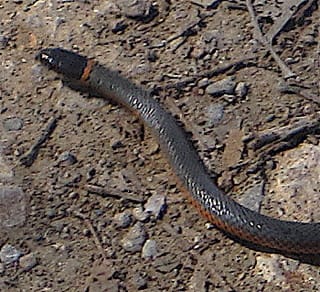 Photo: Akkana Peck |  Ring-necked Snake(Diadophis punctatus)Family: Colubridae (Advanced Snakes) Size: 10 - 30 in (25 - 76 cm) Status: native; uncommon Habitat: moist areas in a variety of habitats including forests, hillsides, upland desert Typical location: Quemazon Neighborhood Nonvenomous. Secretive, usually staying underground. While most guides report that it occurs at elevations below 2200 m (7200 ft), it has been seen in Los Alamos townsite at somewhat higher elevations. Tracks Info Photos Distribution |
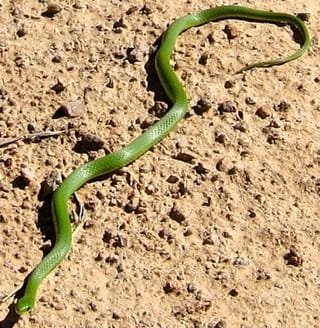 Photo: Yvonne Delamater 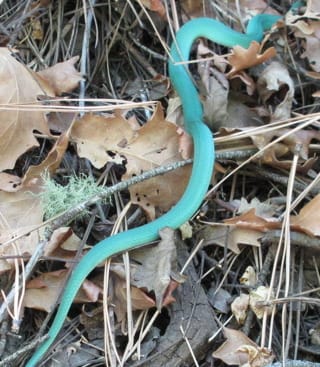 Photo: Barbara Calef |  Smooth Green Snake(Opheodrys vernalis, Liochlorophis vernalis)Family: Colubridae (Advanced Snakes) Size: 14 - 25 in (36 - 64 cm) Status: native; uncommon Habitat: grassy marshes and fields along forest edge, near water; up to 9,500 ft (2,900 m) Nonvenomous. A blue-colored variant (probably axanthic, lacking yellow pigment) has been seen locally. Tracks Info Photos Distribution |
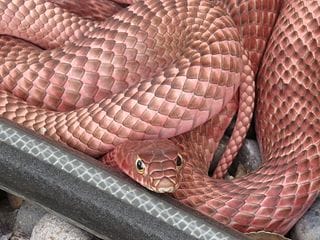 Photo: SantaFeLady 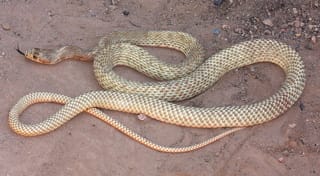 Photo: J.N. Stuart |  Western Coachwhip, Red Racer(Masticophis flagellum testaceus, Coluber flagellum)Family: Colubridae (Advanced Snakes) Size: 36 - 102 in (91 - 259 cm) Status: native; common Habitat: dry open areas, rocky hillsides, chaparral; up to 7,000 ft (2,100 m) Typical location: White Rock, White Rock Canyon Nonvenomous. This snake comes in many colors, though the common local variety is pink, red, brick or coral in coloration. Large eyes, almost appears to have an "angry" expression on its face. While the red variety can be striped, banded, or even mottled in coloration, two less-frequently seen local variations are blackish or tan. These two color patterns tend to be more uniform and have less patterning than the red. Despite myths, this snake is harmless, but they do tend to bite when grabbed. Tracks Info Photos Distribution Featured |
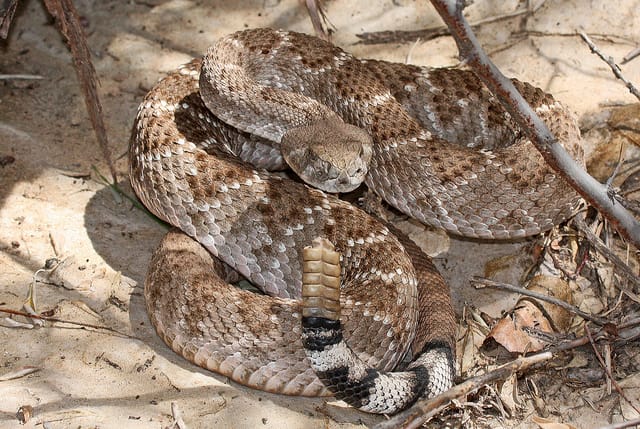 Photo: J.N. Stuart |  Western Diamondback Rattlesnake(Crotalus atrox)Family: Viperidae (Rattlesnakes and Other Vipers) Size: 34 - 85 in (86 - 216 cm) Status: native; common Habitat: rocky areas, arid and semiarid area; generally below 7000 ft (2,100 m) Typical location: White Rock, White Rock Canyon Venomous. Coloration can vary, though usually a gray, light brown or tan background, with darker and highlighted "diamonds" down the back. Obvious triangle-shaped head, readily rattles when approached. Typically one of the larger and heavier snakes found in the area. Tracks Info Photos Distribution Featured |
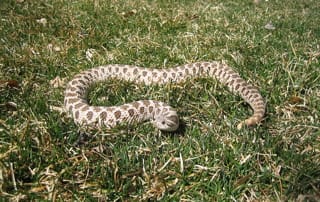 Photo: Jennifer Macke |  Western Hognose Snake(Heterodon nasicus)Family: Colubridae (Advanced Snakes) Size: 16 - 35 in (41 - 89 cm) Status: native; uncommon Habitat: gravelly-soil prairie, chaparral; up to 8,000 ft (2,450 m) Typical location: White Rock, White Rock Canyon Nonvenomous. Secretive. Small snake with yellow or light tan background with darker saddles down its back. Its nose is turned up, giving it a weird facial expression. Will hiss readily when approached, but can also play dead when threatened. Found in lower-elevation areas surrounding Los Alamos. Tracks Info Photos Distribution |
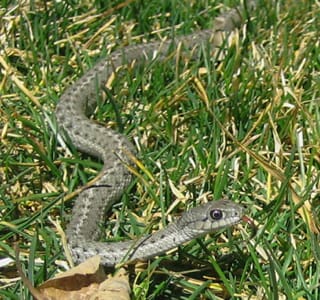 Photo: Jennifer Macke |  Western Terrestrial Garter Snake(Thamnophis elegans)Family: Colubridae (Advanced Snakes) Size: 18 - 42 in (46 - 107 cm) Status: native; common Habitat: open grassy areas near water; up to 10,500 ft (3,200 m) Nonvenomous. One of our most common snakes. Usually gray-brown with subtle checkered pattern or stripes down its back. Often seen near water. Many people think that they may be "water moccasins", but are not. Tracks Info Photos Distribution Featured |
